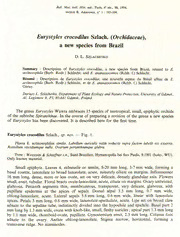
Eurystyles crocodilus Szlach. (Orchidaceae), a new species from Brazil PDF
Preview Eurystyles crocodilus Szlach. (Orchidaceae), a new species from Brazil
Mus. Bull. natl Hist. nat„ Paris, 4*^ ser., 16, 1994, section B, Adansonia, n° 103-104. 1 : Eurystyles crocodilus Szlach. (Orchidaceae)^ new from a species Brazil D. SZLACHETKO L. Summary Description of Eurystyles new from crocodilus, a species Brazil, related to E, : actinosophila (Barb. Rodr.) Schlecht. and E. ananassocomos (Rchb. Schlecht. f.) Resume Description de Eurystyles crocodilus, une nouvelle espece du de Bresil affine E. : actinosophila (Barb. Rodr.) Schlecht. et de E. ananassocomos (Rchb. Schlecht. f.) Garay. Dariusz L. Szlachetko, Department of Plant Ecology and Nature Protection, University of Gdansk, Al PL Lesionow 80-441 Gdansk. Poland. 9. The Wawra genus Eurystyles embraces 15 species of neotropical, small, epiphytic orchids of new the subtribe Spiranthinae In the course of preparing a revision of the genus a species . of Eurystyles has been discovered. described here for the time. It is first — Eurystyles crocodilus Szlach., nov, Fig. sp. 1. Planta E. actinosophilae similis. Ldbellum auriculis valde reductis supra faciem labelli vix exsertis. Rostellum viscidiumque Ovarium perianthiumque glabra. nulla. Type & Hymenopolis Sao WU). Wettstein Schieffner Sued-Brazilien, bei Paulo, 9.1901 (holo-, s.n., : Only known material. mm mm Small epiphyte. Leaves subsessile or sessile, 8-20 long, 3-7 wide, forming a 4, on basal rosette, lanceolate to broad lanceolate, acute, minutely ciliate margins. Inflorescence mm 16 long, dense, more or less ovate, set on very dehcate, densely glandular axis. Flowers on Ovary small, erect, tubular. Floral bracts ovate-lanceolate, acute, ciliate margins. untwisted, membraneous, glabrous. Perianth segments transparent, very dehcate, glabrous, with thin, mm mm papillate epidermis the apices of sepals. Dorsal sepal 3.5 long, 0.7 wide, at mm mm oblong-lanceolate, acute. Lateral sepals 5.6 long, 0.6 wide, linear with lanceolate mm nmi Lipe on broad claw apices. Petals 3 long, 0.6 wide, lanceolate-spathulate, acute. set and adnate to the sepaline tube, indistinctly divided into the hypochile epichile. Basal part 2 mm mm mm long by wide, ovate with knob-Uke, small, fleshy auricles apical part 1.3 long 1.3 ; mm mm Gynostemium Column by wide, rhomboid-ovate, papillate, erect, 2.3 long. foot 1.1 adnate Anther oblong-lanceolate. Stigma narrow, horizontal, forming a to the ovary. No transverse staminodes. ridge. 104 4 4 E E f — apex Fig. 1. Eurystyles crocodilus Szlach. a, flower and floral bract b, dorsal sepal and petal c, lateral sepal d, : ; ; ; of lateral sepal from the outside e, lip gynostemium, bottom view. f, ; ; Etymology form crocodilus : general outline, resembles a head of this reptile. and Eurystyles crocodilus seems to be related to E. actinosophila (Barb. Rodr.) Schlecht. and E. ananassocomos (Rchb. f.) Schlecht., but it differs from the both in the lip form gynostemium The Up between structure. basal auricles of E. crocodilus are intermediate in size E, actinosophila, in which they are large, and E. ananassocomos which has none. All of these and species are autogamous. Both E. actinosophila and E, ananassocomos have long, linear membraneous staminodes, while in E. crocodilus staminodes are completely reduced.
